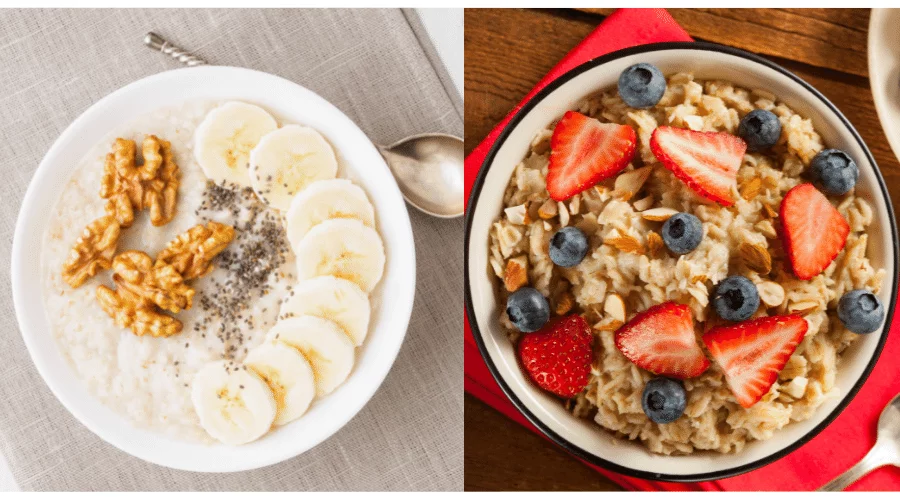For a lot of people starting out their healthy eating journey, thinking of different meals to make multiple times a day can be exhausting. They may resort to eating the same meal all the time to keep mealtime simpler.
But is it ok to be eating the same thing every single day?
How can you easily switch it up and stop eating the same meals on repeat?

Is eating the same meals all the time ok?
To start off with, let’s address whether it’s actually ok to be eating the same things all the time. This actually depends on a few different factors.
If you interpret this as actually eating the same thing for breakfast, lunch, and dinner every single day then no, it’s not ok.
But if it means eating the same meals regularly, like having the same dinner a few times a week or the same breakfast every day, then it’s totally fine. While I absolutely encourage variety and eating multiple sources of different macronutrients as much as possible, there are still some benefits to eating similar meals pretty often.
First of all, if you’re new to healthy eating, it can be reassuring to learn how to make a few different healthy and balanced meals really well and to make them multiple times a week.
Eating pretty similar meals at the beginning of your healthy eating journey can be a good way to build some confidence around balanced eating before you venture out to make different meals with a bunch of varied ingredients.
I actually encourage you to master making a few different healthy meals before moving on to new meals so that you’re not overwhelmed with too many different recipes at first.
Decision fatigue, meaning feeling overwhelmed with all the different decisions you have to make so you end up making poor ones, is a very real thing that can definitely be applied to eating.
If you have to think about what to eat every single meal 3 times a day 7 times a week, if you’re scrolling through dozens and dozens of recipes, looking at thousands of ingredients as you go to the grocery store, then staring at all these different options in your fridge or pantry, it’s really hard to just pick one and do that repeatedly. Eating the same meals all the time can really help alleviate some of the burden of decision-making.

As with most things, it’s all a matter of balance.
If you’re eating the same dinner 5 times a week but the rest of your meals are varied, it’s fine. If you’re eating the same exact meal every day for the whole week, that can become dangerous and you can put yourself at risk of certain nutritional deficiencies.
It’s also important to ask yourself what the intent behind it is: is it just out of convenience? Or is it out of fear of trying new foods and moving away from the foods you find safe? If it’s the latter, maybe working on healing your relationship with food first can be helpful.
It may also just be out of convenience. Maybe you want to eat a variety of food but you just don’t know how. Maybe you feel like you are eating the same meal all the time and you want to be able to switch it up, all while keeping it simple.
In this case, here are a few pointers.
How to stop eating the same thing all the time
Start small
My first tip would be to start out with small things. You don’t want to suddenly change every single meal and your entire way of cooking. You have to start slowly with small things and implement them little by little in order to grow your meal catalog in a sustainable way.
For instance, you can set a small goal of learning how to make one new meal for the week. Then once you’ve mastered that meal, you can include it in your meal rotation, and when you’re comfortable, you can learn to make a new meal, and so on.
This way you will be able to replace the meals that you have on repeat with your new meals little by little. You can also pick one day of the week where you commit to trying something new.
Another way to start small is to pick one ingredient that you like and that you know how to cook and challenge yourself to cook it in different ways. For instance, if you like spinach, you can make some spinach and rice with tofu and coconut milk for one meal, then a spinach quiche for another meal, a big spinach salad with a bunch of different toppings for another one, etc.
Mix and match your basics
What I recommend doing is learning to cook different basic ingredients (which you likely already know how to do!) Once you’ve mastered that, you can easily mix and match them.
For instance, if you’re able to cook different types of grains like whole-wheat pasta, brown rice, quinoa, bulgur… plus if you’re able to cook different proteins like beans, lentils, tofu, eggs, fish… and you’re also able to cook different types of vegetables, it’s then very easy to mix and match them in different ways. You’re probably used to cooking and mixing foods the same way every single time and you just need an easy way to switch it up.
I suggest making a list of each macronutrient o basic food item and then making an effort to mix and match each one with a different one. You can even cut them out, stick them on your fridge, and make it a game to match different things.
Learn to make different sauces and seasonings
Another thing you need to learn to do is is mixing up your sauces and your herbs and spices. Mastering sauces and seasonings can offer multiple different recipes for otherwise similar meals. For instance, making a coconut curry sauce for rice and veggies or a tomato and pesto sauce for rice and slightly different veggies will give you a different meal experience.

Learn to balance out your plates
You may also be eating the same types of meals all the time because you don’t know how to balance out your plate, so you’re more comfortable eating what you already know.
In order to help with that, you can read my article on how to create a healthy plate. In short, this involves filling half your plate with veggies, ¼ with protein, and ¼ with carbs.
Another easy technique to try is the color technique. Basically, this involves assembling your plate with foods of different colors. If you are eating very colorful meals you are likely to be getting a wide variety of nutrients and antioxidants, and this can make plate building more fun and interesting.
Change the toppings
We all have our go-to meal that we eat all the time because it’s convenient, we know it tastes good, and we don’t want to spend time thinking of something new.
An easy way to add some variety to that is to switch up some of the ingredients all while maintaining the same base of the meal.
So for instance, if you like to have oatmeal, instead of having the same banana, peanut butter, and coconut powder toppings you can switch up the toppings each day.
On one day you can have blueberries with almond butter on your oatmeal, on another one raspberries, maple syrup, and sprinkle some cashews…
If you like to snack on fruit and nuts, change up the types of fruit and nuts. If you like salads, sandwiches, smoothies, or soups, switch up one ingredient at a time and see how you like it.

Make meal searching easy and fun
Another way to make sure that you’re not eating the same meal all the time is to make meal searching and meal planning actually easy and even fun.
For instance, one of my favorite ways to find recipes is to use Pinterest. I like to scroll through different pins and whenever I find a meal that looks good (and not too difficult to make!), I save that recipe.
I also like to use different apps where I can select recipe ideas based on the ingredients that I like or that I have on hand, and have recipe ideas suggested to me. I also find great meal ideas by watching other people’s content on what they eat. Basically, anything that isn’t boring (like going through a dusty old cookbook…) can help liven this otherwise tedious process!
In short
While eating the same meals all the time isn’t always a bad thing, there are a few easy ways to ensure that you are getting enough variety in your food intake.
You can learn to cook basic ingredients and then mix and match them, have fun building your plates with different colors or changing out the toppings, incorporate new ingredients or meals little by little, and make meal searching as fun as you can so you actually stick to it.
Hope this helps!
-Lucie

